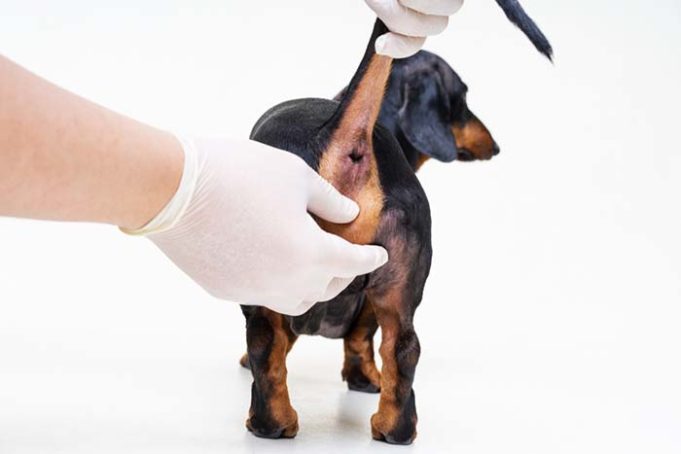The most common type of tumor in dogs is the perianal tumor. A perianal tumor is found in the glands that surround the dog’s anus. The medical terminology for a perianal tumor is “perianal gland adenoma.” These tumors are typically found near the dog's groin, the top or bottom of the tailhead, or the area surrounding the perineum.
Sometimes, perianal tumors in dogs accompany other health problems such as testicular tumors in unneutered male canines, adrenal tumors, and Cushing's disease. It's important for owners to be aware of perianal tumors in dogs because of the high rate of their occurrence. It has been estimated that they account for approximately 80% of all tumors in dogs.
The perianal tumors are more commonly seen in male dogs who have not been neutered. They are less likely to be found in female dogs, but still possible and have been observed in lower rates in females. The reason female canines, especially ones that have not been spayed, are less likely to be affected by a perianal tumor is because estrogen typically inhibits these tumors from forming.
Symptoms of Perianal Tumors in Dogs
If you suspect that your pup may be suffering from a perianal gland, you should look for the following symptoms:
- A mass that slowly grows around the dog's anus, typically in hairless areas
- They are usually painless and will not cause your dog discomfort
- One or more masses may be present
- Sometimes the tumor may ulcerate and become infected*
- Difficulty eliminating waste
*If your dog’s tumor ulcerates and becomes infected, the area may be sensitive or even painful. This will make their ability to defecate without pain difficult.
Causes of Perianal Tumors in Dogs
The exact cause of perianal tumors is still not known to scientists; however, it is believed that perianal tumors are most likely caused due to a hormone imbalance. Because of the hormone estrogen, female dogs who have not been spayed are less likely to have perianal tumors, but they're still at risk.
Sometimes, a hormone imbalance is caused by a dog’s thyroid function. If your dog has a known thyroid problem, talk to your veterinarian about the potential for a perianal tumor developing. Some factors that increase a dog’s risk of perianal tumor development include, but are not limited to:
- Males who have not been neutered or castrated
- Dogs who are 8 years of age or older
- Females who have not been spayed
- Specific dog breeds are more prone to the disease
Diagnosis of Perianal Tumors in Dogs
Breeds that are thought to have an increased risk of developing a perianal tumor include:
- Siberian Husky
- Samoyed
- Pekingese
- Cock-a-poo
- Cocker Spaniel
- Brittany Spaniel
- Lhasa Apso
- Beagle
- Shih Tzu
- Mutts
And dog breeds that were observed to be at the lowest risk of developing this issue are:
- German Shepherd
- English Springer Spaniel
- Standard Poodle
- Labrador Retriever
- Miniature Schnauzer
- Great Dane
- Golden Retriever
- Doberman Pinscher
- Boxer
- Rottweiler
For a dog to be properly diagnosed with perianal tumors, you first need to visit your veterinarian where they will perform a complete physical examination. Additional testing will most likely be necessary. There are three different types of tests that can be used to diagnose perianal tumors in dogs:
- Needle biopsy – a small needle takes a sample from the tumor so that the cells can be examined
- Full biopsy – if a diagnosis cannot be made with a needle biopsy, your veterinarian may move to a full biopsy
- Imaging – some veterinarians use x-ray or ultrasound imaging to view and diagnose the mass
Treatment of Perianal Tumors in Dogs
Unfortunately, the treatment options for perianal tumors is limited. Surgery and radiation are suggested; however, there is no non-surgical cure. Even after tumors are removed through surgery, they may come back.
Thankfully, recurrence happens in less than 10% of affected dogs. Additionally, radiation therapy may be needed or suggested by your veterinarian. Overall, the prognosis for untreated perianal tumors is poor, but with complete removal of the perianal tumors the prognosis is quite good. While the prognosis is poor, surgery is typically suggested because it can prolong your dog’s life and keep them comfortable.
If your dog’s perianal tumor has ulcerated and become infected your veterinarian will most likely prescribe antibiotics and/or an ointment to help your dog heal prior to performing surgery to remove the tumors and the surrounding lymphatic glands.
After diagnosis and treatment, your vet may suggest additional testing to ensure the dog had properly functioning kidneys. This is imperative because it will help reduce the chance for recurrence. You should keep your dog’s surgical site clean and ensure that they do not lick their wounds. Veterinarians may suggest that your dog wear a cone collar to reduce the risk of them infecting their incision site by licking it. Your dog should also be kept calm during the recovery process.
Prevention if Perianal Tumors in Dogs
The best way to prevent this in your male dog is to neuter them. Females who are left intact have less of a chance of being affected by perianal tumors; however, it is important to understand other potential risks of leaving your pup intact.
If you have a female dog and are considering skipping her spay surgery, to avoid the possibility of perianal tumors talk to your veterinarian first. Sometimes the risk of perianal tumors associated with spaying female dogs is lower than other health problems that may occur if you leave your female dog intact.
After diagnosis and treatment, your dog can return to a comfortable life and the likelihood of relapse is statistically relatively low.
READ NEXT: Dog Breast Cancer – A Brief Guide













